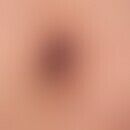Synonym(s)
HistoryThis section has been translated automatically.
DefinitionThis section has been translated automatically.
Rare, superficial, nevoidal vascular neoplasms, occurring predominantly in girls (during puberty) and young women (relapses during pregnancy possible).
Occasionally associations with systemic diseases have been described (Sjögren's syndrome, primary biliary cirrhosis, paraproteinemia), without a pathogenetic explanation for these comorbidities.
You might also be interested in
Occurrence/EpidemiologyThis section has been translated automatically.
Gynecotropy: Women are affected about 9 times more often than men.
EtiopathogenesisThis section has been translated automatically.
Unknown.
ManifestationThis section has been translated automatically.
Mostly occurring in childhood (80% of patients are affected before the age of 18). Rarely present at birth.
LocalizationThis section has been translated automatically.
ClinicThis section has been translated automatically.
Disseminated, 1-2 mm in size, bright red to purple-coloured, sometimes non-removable, dot-shaped spots. Occasionally also telangiectasias. Serpiginous, gyrated or linear patterns are produced by grouped arrangement. Occurring on one or both sides (rather symmetrical). Palms, soles and the mucous membranes close to the skin remain free.
Manifestations along the Blaschko lines are rarely described.
HistologyThis section has been translated automatically.
Convolute dilated capillaries with or without thickening of the vessel wall in the papillary stratum, sometimes also capillary proliferation and erythrocyte extravasations. No inflammatory infiltrates.
Differential diagnosisThis section has been translated automatically.
TherapyThis section has been translated automatically.
Laser therapy(e.g. pulsed dye laser) can be applied with good results.
Alternative: diathermy needle sclerotherapy.
Supplementary: cosmetic cover.
Progression/forecastThis section has been translated automatically.
LiteratureThis section has been translated automatically.
- Al Hawsawi K et al (2003) Linear angioma serpiginosum. Pediatric dermatol 20: 167-168
- Chavaz P, Laugier P (1981) Angioma serpiginosum Hutchinson: ultrastructural study (author's transl). Ann Dermatol Venereol 108: 429-436
The D et al (2016) Blaschko-linear angioma serpiginosum. Indian JDermatol
Venereol Leprol 82:335-337.Gerbig A et al (1995) Angioma serpiginosum, a skin change along the Blaschko lines. Dermatologist 46: 847-849
Kalisiak MS et al (2008) Angioma serpiginosum with linear distribution: casereport
and review of the literature. J Cutan Med Surg 12:180-183.Katta R et al (2003) Angioma serpiginosum with extensive cutaneous involvement. J Am Acad Dermatol 42: 384-385
- Namazi MR et al (2003) Angioma serpiginosum. Dermatol Online J 9: 19
- Radcliffe-Crocker H (1893) Diseases of the skin: their description, pathology, diagnosis, and treatment, with special reference to the skin eruptions of children. P. Blakiston, son & Co, Philadelphia, S. 646
- Sandhu K, Gupta S (2005) Angioma serpiginosum: report of two unusual cases. J Eur Acad Dermatol Venereol 19: 127-128
Outgoing links (7)
Blaschko lines; Diathermy; Fabry's disease; Hereditary haemorrhagic telangiectasia ; Laser; Purpura pigmentosa progressive; Varice reticular;Disclaimer
Please ask your physician for a reliable diagnosis. This website is only meant as a reference.




